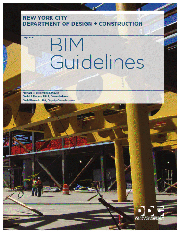Posts Tagged: Guidelines
03. NYC-BIM never sleeps
NEW YORK CITY
DEPARTMENT OF DESIGN + CONSTRUCTION 2012
 Message From
Message From
The Commissioner
Managing the design and construction for New York City’s capital projects is an increasingly collaborative process. Our consultant design teams include many separate firms representing the various disciplines and specialties, whose work must be tightly coordinated.
Our consultants must work closely with DDC and with our client agency representatives as well as with other city agencies involved in the design and construction of a civic building. Because of this, DDC continually looks for ways to improve the collaborative process. One way to do so is by using Building Information Modeling. BIM strengthens
collaboration by allowing all members of the design team to accurately add to a shared database information about how a building looks and functions. Using this information, the BIM database creates a virtual model of a building at every stage – from design conception through construction and occupancy.
BIM is currently being used on major projects around the world and is quickly becoming an industry standard. It not only provides us with a virtual representation of our projects at all stages, but also tracks and analyzes design, construction, and operational information that
are critical to the success of these projects. Shared access to this information creates valuable insight across the building lifecycle and
can help improve project management performance. We believe that the successful integration of civic building design,
delivery, and operations through BIM will streamline the project management process, resulting in cost-savings and more on-time
completion. We are committed to broadening and accelerating the adoption of BIM for City projects. We have been working closely with
the A/E/C community and other public works agencies regionally on appropriate uses and optimizing the benefits from BIM, and we are
pleased to introduce this Citywide BIM standard that will be used for DDC projects and may be adopted by other agencies and organizations.
Sincerely,
David J. Burney, FAIA
